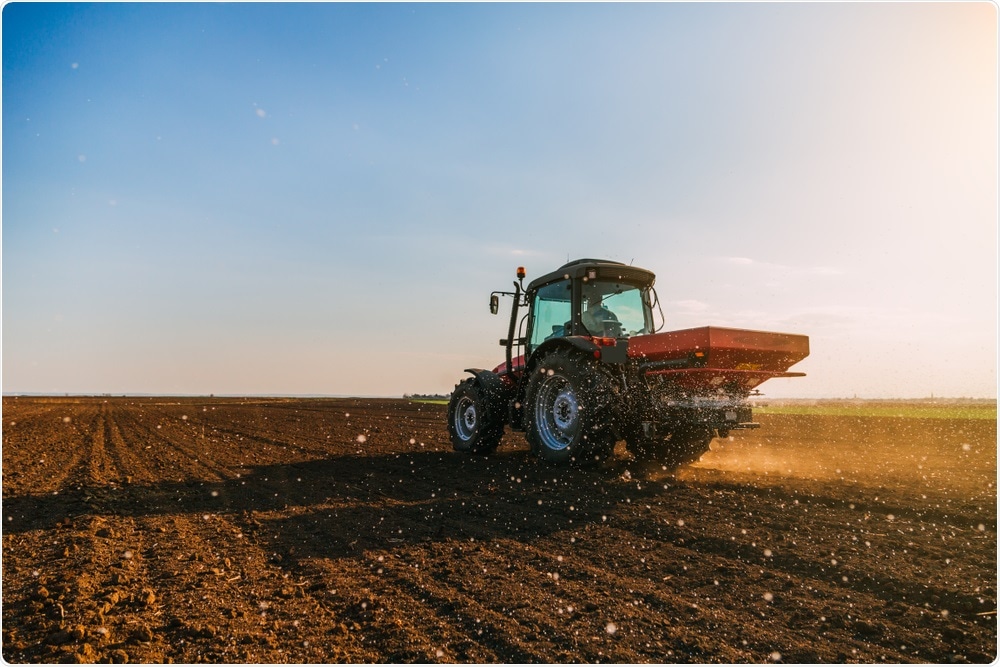Nitrogen is significant to the agricultural sector. Each year, beyond 100 million tonnes of nitrogen are used for crops in the form of fertilizer to assure that adequate food is produced to feed the constantly growing global population.

Fertilizer. Image Credit: oticki/Shutterstock.com
As part of the nitrogen added is not taken up by plants, there is an unavoidable surplus that results in the run-off to surface water, which in turn contributes to algal blooms and biodiversity loss.
To handle this issue and enhance the health of both ecosystems and people, the majority of the regions and countries have put forth or enforced measures to restrict nitrogen pollution. But there is still poor knowledge on the trade-offs between food security (which involves the use of nitrogen) and environmental targets (which demand a decrease in nitrogen use).
A group of scientists from the International Institute for Applied Systems Analysis (IIASA), Wageningen University, the Netherlands, Zhejiang University, China, and Ritsumeikan University, Japan, investigated the potential effects that existing nitrogen-related alleviation options could have on conciliating regional food security and environmental targets for nitrogen in recent research published in the Nature Food journal.
The researchers acquired regional nitrogen surplus boundaries for 37 global regions and demonstrated that the current nitrogen inputs cross those boundaries in 14 of these regions, including high nitrogen input regions like China, India, and Western Europe. The scientists later examined the trade-offs between regional food security and reaching those nitrogen boundaries with existing management.
Additionally, they pinpointed the impacts of alleviation options to reconcile the tension between regional food production and environmental targets for nitrogen.
Our findings suggest that policies promoting the mobilization of a comprehensive set of nitrogen mitigation options would allow compliance with proposed nitrogen sustainability boundaries without worsening food security across the world.”
Jinfeng Chang, Study Lead Author and Guest Researcher, Integrated Biosphere Futures Research Group, IIASA Biodiversity and Natural Resources Program
“Hunger could be significantly alleviated, putting 590 million fewer people at risk of hunger from 2010 to 2050, even when respecting regional nitrogen surplus boundaries. Such policies could also have other environmental and economic co-benefits beyond the impacts of nitrogen pollution,” added Chang.
The scientists reviewed numerous strategies including promotion of higher nitrogen use capability in agronomic practices, enhancing manure recycling and sewage management, decreasing harvest losses and food waste, and encouraging a shift in diets away from animal products.
Amidst these strategies, rising nitrogen use efficiency surfaced as the most efficient strategy to lessen undernourishment while respecting the defined nitrogen boundaries. However, considering the scale of the challenge, policies that promote and encourage several nitrogen alleviations options, both on the supply and demand side, need to be enforced simultaneously to deal with nitrogen pollution.
A balance between food availability and regional nitrogen surplus boundaries could also be improved through international trade in agricultural products by promoting exports from regions that are not exceeding their nitrogen boundaries to the regions that need to reduce their nitrogen inputs in order to address a nitrogen surplus.”
Jinfeng Chang, Study Lead Author and Guest Researcher, Integrated Biosphere Futures Research Group, IIASA Biodiversity and Natural Resources Program
“However, if efforts to reduce the nitrogen surplus in middle-income developing regions such as East Asia, the Middle East, North Africa, or South Asia, were based on reduced domestic supply rather than improving nitrogen use efficiency, this could have severe spillover effects on food security in the least developed regions such as Sub-Saharan Africa and Southeast Asia,” added Chang.
It could also exacerbate other environmental challenges, such as deforestation in Latin America.”
Jinfeng Chang, Study Lead Author and Guest Researcher, Integrated Biosphere Futures Research Group, IIASA Biodiversity and Natural Resources Program
Source:
Journal reference:
Chang, J., et al. (2021) Reconciling regional nitrogen boundaries with global food security. Nature Food. doi.org/10.1038/s43016-021-00366-x.